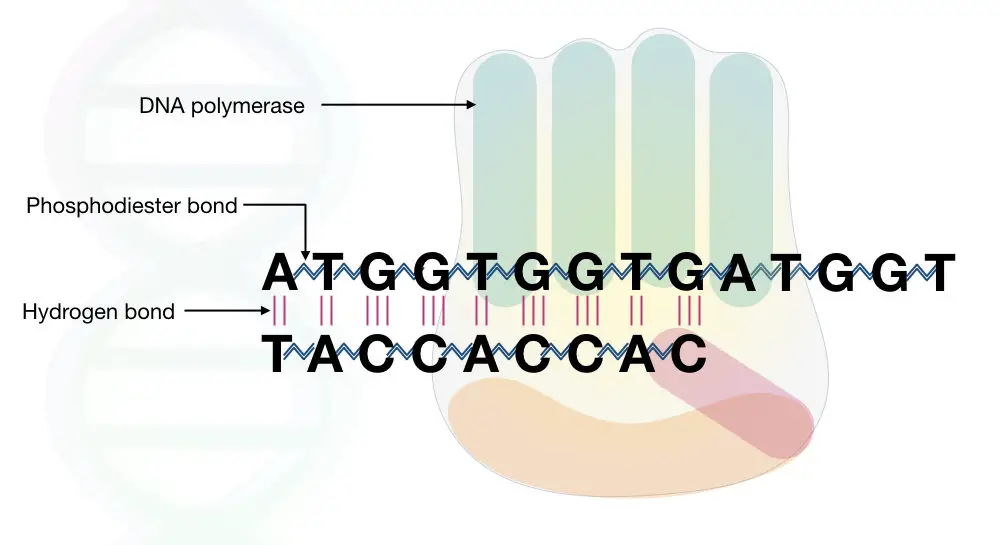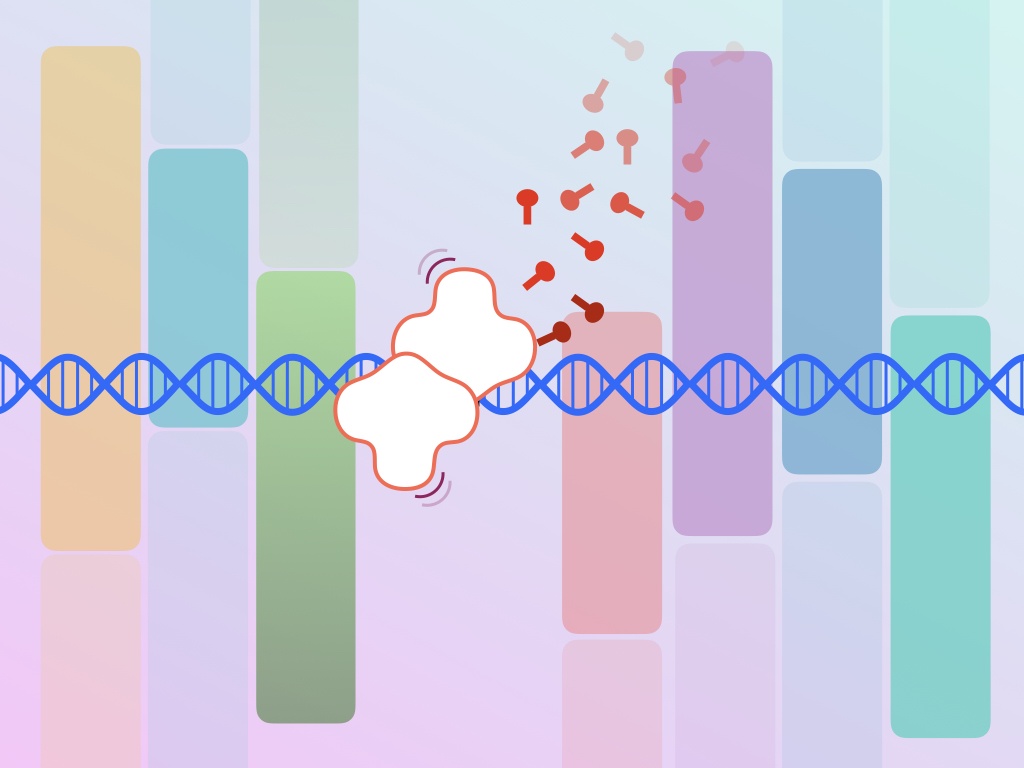“The process of making new deoxyribose nucleic acid (DNA) is known as DNA synthesis. An enzyme polymerase catalyzes the synthesis reaction.”
DNA synthesis is a natural process found in all organisms and we know it as replication. The synthesis process is also very useful in various genetics and genomics studies. The in vitro or artificial DNA synthesis process is different although.
In the present article, we will discuss both in vivo and in vitro process of DNA synthesis and how it occurs. But before that, we have to understand the natural mechanism of how new DNA is formed.
Key Topics:
In vivo DNA synthesis:
Replication is a process of synthesizing new DNA. A Special type of protein molecule plays a significant role in this process. That protein is known as an enzyme and catalyzes the synthesis reaction (i will tell you later which enzyme it is!).
DNA is made up of three components (sugar + phosphate + bases) collectively referred to as nucleotides. A polynucleotide chain forms various genes.
The very first step in replication is the unwinding of DNA by helicase. The helicase is a class of enzyme that makes dsDNA single-stranded. Using primer’s 3’ OH end another enzyme starts nucleotide insertion. Once the entire process is completed, newly formed DNA transmits into the daughter cell. This way cell division occurs and genetic material replicates.
The entire process of synthesis is dependent on the activity of a special class of enzyme but the question is, which enzyme is this?
The answer is “polymerase”.
Role of DNA polymerase:
DNA polymerase is a special class of polymerase enzyme that can only synthesize DNA. Interestingly, not all polymerases are similar. For instance, the DNA polymerase requires an oligo sequence known as a primer to start synthesis, while the RNA polymerase directly synthesizes RNA.
There are few more differences between both but for that, you have to read this article: Differences between DNA polymerase vs RNA polymerase.
Anyway, So as I said, the DNA polymerase needs primer (either DNA primer or RNA primer) as a starting material for synthesizing DNA. DNA synthesis can’t be initiated until polymerase recognizes the primer.
We have written a series of articles on this topic. You can read it here:
In vitro DNA synthesis:
The in vitro synthesis meaning that the synthesis process occurs outside the body or system. Instead of enzymes, the in vitro synthesis is done by temperature thus the process is known as amplification.
Unlike the natural process, using various temperature gradients a machine forms new DNA copies in a cyclic reaction known as polymerase chain reaction (The machine is known as thermocycler).
PCR copies DNA using a special type of DNA polymerase known as Taq DNA polymerase. The Taq is utilized here because of its capacity to function at a higher temperature.
Here also, a short, single-stranded primer is used for amplification like the replication. First, at a higher temperature, the dsDNA denatures and unwinds. Then in the next step, primer binds to its complementary sequence. And in the last step, the Taq DNA polymerase inserts nucleotides.
This is a kind of broad overview of DNA synthesis but the question here is why DNA synthesis is so important?
Importance of DNA synthesis:
DNA is a blueprint of life. It stores, transfers, and expresses biological information within organisms. Therefore, maintaining its integrity is crucial for our survival.
In vivo DNA synthesis- a replication process copies DNA and transfers it to the daughter cell in the exact same form.
It also helps in maintaining information by avoiding mutations. Also, it repairs broken and damaged DNA through various pathways. Overall we can say, through synthesis, the biological information remains intact and in original form.
Nonetheless, the function of in vitro DNA synthesis is totally different. Let me explain to you in detail. Why are we doing amplification? What is the purpose of PCR?
To get DNA copies, right! But why do we need DNA copies?
See DNA is very tiny, we can’t see it by the naked eye even a powerful electron microscope is not able to examine the spiral structure of DNA. Now image, can we do research with a few copies of DNA? No, we can’t. A prominent, distinct, and clear DNA band can only be visible by amplifying DNA.
Furthermore, only to study a single few thousand base pair DNA or gene, using entire genomic DNA (of 3.4 billion bp) is a worse idea.
A gene-specific primer amplifies only the gene of our interest or the DNA sequence we wish to study. Artificial DNA synthesis gives great value in gene-specific studies. The artificial synthesis process has tremendous applications and advantages in various fields. It is useful in,
- Mutation and mutagenesis studies
- DNA sequencing and identification
- Genotype and phenotype studies
- Disease diagnosis
- Metagenomic studies
- Pathogen and microbial identification
- Species and speciation studies
The direction of DNA synthesis:
The polymerase functions in a specific direction. The natural DNA polymerase has two significant activities of synthesis as well as proofreading. Our Taq DNA pol of artificial synthesis only have synthesis activity.
During proofreading, polymerase goes back to repair unmatched nucleotides inserted during synthesis. Repairing wrong nucleotides doesn’t make sense DNA during PCR amplification, because we only need copies of DNA. So proofreading activity is not required.
But, during DNA sequencing, proofreading is essential. A single wrong base signal ruined the entire sequencing and we can’t get the exact sequence. So the Taq that is used in DNA sequencing has both synthesis and proofreading activity.
(These things are so technical).
Conclusively, the DNA polymerase used in the natural replication process and DNA sequencing have both synthesis and proofreading activity while a DNA polymerase employed in PCR has only synthesis activity.
(Note: Taq with both proofreading and synthesis activity are costlier, therefore, we avoid it in PCR).
Polymerase synthesizes DNA from 5’ to 3’ direction and performs proofreading from 3’ to 5’ and 5’ to 3’. I think we should understand it at a molecular level.
The DNA molecule is double-stranded and arranged spirally. It’s one end has a free 3’ OH end while the other end has a free 5’ phosphate end. DNA polymerase needs a short 20 to 23 nucleotides long primer and a 3’ OH end to start synthesis.
See the image below,

As it finds the 3’ OH immediately it starts synthesis. Once the polymerase settles on its substrate, it starts forming bonds between nucleotides. It makes two different bonds hydrogen bonds and phosphodiester bonds between the nucleotides of two different strands and adjacent to one another, respectively.
That is how the entire mechanism of synthesis occurs. In addition to this artificial DNA synthesis has great importance in other genomics studies as well.
Primers and probes, what we are using in PCR, DNA sequencing, and microarray are now synthesized artificially. Scientists make synthesis genomes in which the entire genome of an organism is artificially constructed to replace the faulty one or in other in vitro research.
Read our article on synthetic genomics: Synthetic genome.
The DNA of fossils and extinct species are now artificially constructed and stored for future research.
Conclusion:
Artificial DNA synthesis is a tedious process and not so fast as replication. During replication, thousands of nucleotides are inserted per second, while during artificial synthesis it is actually not possible for us, it takes time.
Nonetheless, in vitro DNA synthesis has numerous applications in biology.


